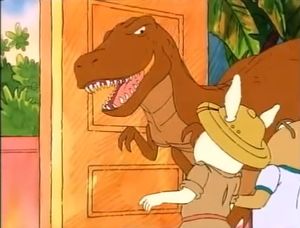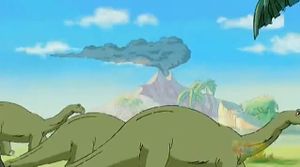The forum pages are fully operational! See this link for the latest forum topics, where users can collaborate or discuss certain topics in one place!
Difference between revisions of "List of Dinosaur References in Arthur"
| Line 60: | Line 60: | ||
=== Brachiosaur === | === Brachiosaur === | ||
[[File:Brachiosaurus_z1.jpg|thumb|Brachiosaurs late Jurassic]] | [[File:Brachiosaurus_z1.jpg|thumb|Brachiosaurs late Jurassic]] | ||
Brachiosaur is large surapod that ate plants. It had few preditors when they are full grown, but younger Brachiosaur had to worry about being targeted by creatures like Allosaurus. They would live in large heards and because of there diet of vegitation they would really stink. It lived with | Brachiosaur is large surapod that ate plants. It had few preditors when they are full grown, but younger Brachiosaur had to worry about being targeted by creatures like Allosaurus. They would live in large heards and because of there diet of vegitation they would really stink. It lived with Apatosaur during the Late Jurassic in North America. | ||
=== === | === === | ||
Revision as of 21:52, 1 May 2012
There is a lot of reference to historical figures and celebrities in the Arthur series. One of the other things that takes part of the series is dinosaurs. These prehistoric creatures have appeared in "Buster's Dino Dilemma" to the more recent season, in "Follow the Bouncing Ball". Here are the Dinosaurs that appeared in the series:
Tyrannosaurus Rex
The largest predator in Western North America is the Tyrannosaururs Rex. It was meat eater, due to its size of his head he could not hunt like normal preditors, but instead it would hunt in packs or scavange for injuried or old prey. The Tyrannosaurus is related to the Velocaraptor. That means it would of had feathers but not on the adults but on its young. Tyrannosaurus Rex can run up to 60 miles per hour and the female T-Rex is the largest of the species. As a T-rex grows it loses teeth and is replaced more stronger, sharper teeth that can break bones, as well as the males become brightly coloured and female become dull in colour. While adult t-rex are much slower than baby t-rex. The adult t-rex appearances change as the creature grows. The Tyrannosaurus appeared in "Buster's Dino Dilemma", "Sue Ellen and the Brainasaurus", and "On This Spot".
- Adult T-Rex.png
Adult Tyrannosaurus
- Young Adult T-Rex.png
Young Adult Tyrannosaurus
- Teenage t-rex.png
Teenage Tyrannosaurus
- Baby T-rex.png
Baby Tyrannosaurus
Troodon
Troodon is a very small dinosaur compared to those of its time. It mainly hunted in packs but most of the time they hunted small animals like early mammals, lizards and birds. They are the smartest dinosaur know in the fossil records, They were found all over North America. The Troodon is covered in feathers. Troodon is the unknown dinosaur that appeared in "On this Spot".
Apatosaurus
Apatosaurus is a large herbivore. It lived in North America during the late Jurassic Period. It moved larged in huge groups that move from food source to food source. Apatosaur lays its eggs in large cluches in spots they build nests. There is not much we know except that they eat rocks to digest the plants. And their off spring is left alone to defend there self after birth. So they proble hide under low brush until they are big enough to leave the forest. After that they countinue to eat until they reach a size 23 meters and weigh to 23 metric tones. Apatosaurus appeared in "Follow the Bouncing Ball".
Triceratop
A large herbivore. They lived in large groups where their is an Alpha Male and Alpha Female. Their would usely other females in the group including immature males. There main defense is create an wall of horns as they circle around their youth in the middle. The other purpose for the horns on the Triceratop is to make its appearacance different from other species. The ultimate reason is to impress female tricerstops like the feathers on male peacocks uses there tail feathers to impress the female peacock. The males are brightly coloured while the female are dull in colour. A baby triceratop has a flat crest and small horns, while a teenage have a boney crest and horns sticking up than forward, young adult Triceratops have a spiky crest and long straten horns and fully grown Triceratops have no bone creast and lawrger horns. A mother Triceratop takes care of there young untill they are teenages. The Triceratop lived in the Western Part of North America. Triceratops was menchened in "Buster's Dino Dilemma".
- Baby triceratop 2.png
baby triceratop
- Teenage Triceratop.png
teenage triceratop
- Young Adult Triceratop.png
Young Adult Triceratop
- Adult Triceratop.png
Adult Triceratop
- Male Triceratop.png
males are brightly coloured
- Female triceratop.png
females are duller in colour
Anurogathus
The Anurogathur was a small flying reptile that lived in North America during the late Jurassic period. It mainly ate insects. It would flap its wings to gain height. It made its apparance in the episode, "Follow the Bounceing Ball".
Corythosaurus
A large hadrosaur that had lived in the North Pole. They are a large herbavoire from the late Creteous Period. They had long nasal passage that great huge chamber that connects to the respatory system. This chamber allows it to create sounds. It has a elaberate crest. The Corythosaurus appeared in "DW Tricks the Tooth Fairy".
Astrodon
A large herbivore surapod, it is related to the brachiosaur. It lived in the Eastern part of North America during the early Creteous period. They made an appearance in "Arthur Perfect Brother" and "Buster's Dino Dilemma".
Pteranodon
A flying reptile that lived during the late Cretaeous in North America. They lived over the Western Interior Sea, which today is the the central part of US and Canada. They have a diet of eating fish, and small reptiles. Pteranodons are not dinosaurs but flying reptiles, and can not fly but glide with the updrafts, and strong gust of wind. It had the second largest wing span behind the Quetzalcoatlus. It was the pet Buster Baxter wanted in "Francine and the Feline".
Acrocanthosaur
A large bipedale dinosaur that lived during the Early Cretaeous in Eastern North America. There fossils have
been found from Texas to Washingon D.C. It was prehistoric carnivore and largest donosaur in the region. It would of hunted the large herbivore Astrodon. It appears in "On This Spot" being the largest dinosaur ever found in Elwood City.
Stegosaur
Stegosaur is an armoured dinosaur with large plated and a spike tail. The eat plants and can be seen living in feilds with large heards of Camptosaurus. They are considered to be not that intellegent in fact, studies state that it had a good concentration. It will concentrate on one thing before moving on to another. It is famouis for fending off large carnivores like Allosaurus. They lived with Apatosaur in North America during the Late Jurassic period. It appeard as a gum watt model made by George in Desk Wars.
Users Requests
Brachiosaur
Brachiosaur is large surapod that ate plants. It had few preditors when they are full grown, but younger Brachiosaur had to worry about being targeted by creatures like Allosaurus. They would live in large heards and because of there diet of vegitation they would really stink. It lived with Apatosaur during the Late Jurassic in North America.
Allosaur
Allosaur lived with Apatosaur and predator to creature such as Stegosaur, Apatosaur, and Brachiosaur. They are not the largest preditor during the Jurassic period. The largest preditor at the time was Torvosaurus, but it is smaller and faster than the larger Torvosaurus, Allosaurus will show signs intimination so it can get its way. Allosaurs are most famous for there complete skeletons including Big Al. They lived in North America, Europe and Africa during the late Jurassic period.
Diplodocus
Diplodocus a large surapod that ate mostly plants. Like most surapods they started very small, living in dense forests eating on small shrubs, over time they grow huge sizes can wait more than a tone. There breeding habiits are simple, they lay an egg in a small cluch and walk away. They have few preditors but they do have a great self defense, there long tail can be used as a whip. They do live in large heards of mostly female. They lived during the Late Jurassic in North America. They tend to be a nomad species moving from location to location.
Cryptoclidus
Cryptoclidus is a fish eater. They live in shallow water and can move on to dry land. They are eligent swimmers and can out move larger preditors. They do need to go out into deeper waters to hunt where they are vulnerble to preditors. At night they sleep on the beach. Cryptolidus lived during the middle Jurassic Period, Cryptoclidus lived in the ocean near europe.
Elasmosaurus
The Elasmosaurus is the largest Plateosaurus. It hunted fish, birds, and small reptiles. They lived in the Western Interior Sea, which today would have been the great prairies of Central North America. They are air breathers and must come to the surfice to breath air. There only compition is another Elasmosaurus. They lived during the late Cretaceous.
Daspletosaurus
Daspletosaurus is related to the Tyrannosaurus rex. It had useless small hands. So it relied on its giant head to do most of the hunting. Like T-rex they hunted in Packs. There babies are born with feathers and the females are the biggest of the species. They lived in North America during the late Cretaceous.
Giganotosaurus
Gigantosaurus is largest preditor that lived in South America. As the name states it is huge, it was capable hunting any wild life including the large Argentinasaurus. There is not much information on Gigantosaurus some scientist assume they lived a solitary life or they may make large gangs to hunt prey. They lived in South America during the late Cretaceous.
Microraptor
Microraptor is a small raptor that lived in the trees. They mainly eat bugs and lizards. They are covered in feathers and have two sets of wings on its arms and legs. This allows it to glide from tree to tree. Its claws help it climb trees. They have the best preserved fossils in fossil history and the first species of dinosaur to concluded that there evolutionary path is linked to birds. They lived during early cretaceous in China.
Edmontosaurus
A large dinosaur, At 26 feet and weighting up to four tons, this dinosaur would have been the size of a truck. It
was named after the city of Edmonton and is a herbivore. During the winter in the Late Cretaceous they would migrate from the Artic to the Southern part of North America. They lived in North America during the Late Cretaceous.
Parasaurolophus
A large herbivore dinosaur, it has a large creast on its head, scientist believe that the creast allows it to
communicate with other Parasaurolophus. Parasaurolophus can move from quadraped to bipedal. They are found in North America during the Late Cretaceous.



